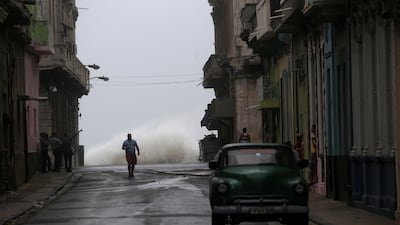Parts of Cuba are underwater after Hurricane Irma ploughed into the island's north coast.
People walked through ankle-deep water in Caibarien, a fishing town where streets were flooded and covered in seaweed. Elsewhere, winds of 256 kilometres per hour uprooted trees and utility polls, ripped the roofs apart and unleashed waves of up to seven metres.
It was the first time the eye of a Category 5 storm had made landfall in Cuba since 1932, state media said, and the island's Communist government ordered the evacuation of more than a million people from its path.
Irma made landfall on the island's Camaguey Archipelago late on Friday. Close to a million people, including about 4,000 from the capital, Havana have left their homes to stay with relatives or in shelters and the electricity supply cut as a precautionary measure.
"Oh God, this is going to destroy the town," said a local woman who identified herself only as Francis, 19. "The water was already at the corner near my house. By now it will be full of water," she said.
— Park benches torn up —
Ambulances and firefighters patrolled streets littered with hunks of roofs, power lines and tree branches cast down by strong winds. In one park, the wind tore up benches that had been screwed down into concrete. Local radio issued constant messages warning people not to leave their homes while the hurricane passed. Yet some still came out into the streets on bicycles to check on their friends and relatives.
Ramon Cobas, 72, and his wife Rosa, 64, sheltered six relatives in their house, one of the sturdiest buildings in the town. Fragments of glass from other buildings struck the house as they huddled inside.
"These winds are stronger than those of Kate," said Rosa, referring to the devastation wrought in 1985 by Hurricane Kate. "I'm afraid even this house will fall down. And I am afraid for the neighbours."
Residents were also afraid of flooding since the town has no storm drains in its streets.
— Serious damage —
A large part of the centre and east of the island was without power and though Havana, with its two million population, was forecast to receive just the tail-end of Irma, civil defence authorities placed it and two neighbouring provinces on maximum flood alert. Enormous waves lashed the Malecon, the capital's emblematic seafront, causing seawaters to wash some 250 metres into the city.
Leonor Herrera, 64, said the last time she witnessed waves in the city was during 2005's Hurricane Wilma, when the water "was up to our knees."
"At the moment, it's not so high, but there's times when it rises and you must run inside," she said.
Tourism minister Alexis Trujillo said authorities had evacuated 10,000 foreign tourists from all the hotels on the coast around Havana, a major destination for foreign tourists, and.
There were no confirmed casualties in Cuba, but the hurricane killed at least 25 people earlier on its path across the Caribbean.
Irma is expected to strike the Florida Keys early Sunday before moving up the mainland peninsula.
In Florida, a total of 6.3 million people, or about a third of the state's population, have been ordered to evacuate, including President Donald Trump's waterfront Mar-a-Lago estate in Palm Beach.
"This is a storm of enormous destructive power, and I ask everyone in the storm’s path to heed ALL instructions from government officials," Trump said on Twitter.
The bill for loss and damage could hit $120 billion (100 billion euros) in the United States and Caribbean, according to data modelling firm Enki Research.
Before slamming into Cuba, Irma had caused havoc in lush Caribbean resorts such as St. Martin, St. Barts, St. Thomas, Barbuda and Anguilla.
Many of Irma's victims fled their battered islands on ferries and fishing boats for fear Hurricane Jose would destroy or drench anything Irma left untouched, but Jose veered away before doing much more damage.
On the Dutch side of St. Martin, (known as St Maarten) an island divided between French and Dutch control, an estimated 70 per cent of the homes were destroyed by Irma, according to the Dutch government. Prime minister William Marlin said about 1,600 tourists had been evacuated and efforts were being made to move 1,200 more. Twenty-eight of the island's police officers lost their homes.
St Maarten saw widespread looting and robbery after Hurricane Irma but the Dutch navy said the security situation had improved thanks to patrols by marines and police flown to the island to help the local force.
Mr Marlin said many countries and people have offered help to St. Maarten, but authorities are still trying to determine the extent of damage to the island. The US state department helped more than 500 Americans fly out of St. Martin, starting with those in need of urgent medical care. Carol Basch, 53, a tourist from Savannah, Georgia, took refuge in the bathroom of her St. Martin hotel room after the storm windows shattered. She was evacuated to Puerto Rico.
"I'm glad I'm alive. I didn't think I was going to make it,." she said.
Hurricane warnings wee downgraded for Barbuda and Anguilla and discontinued for nearby Antigua.

